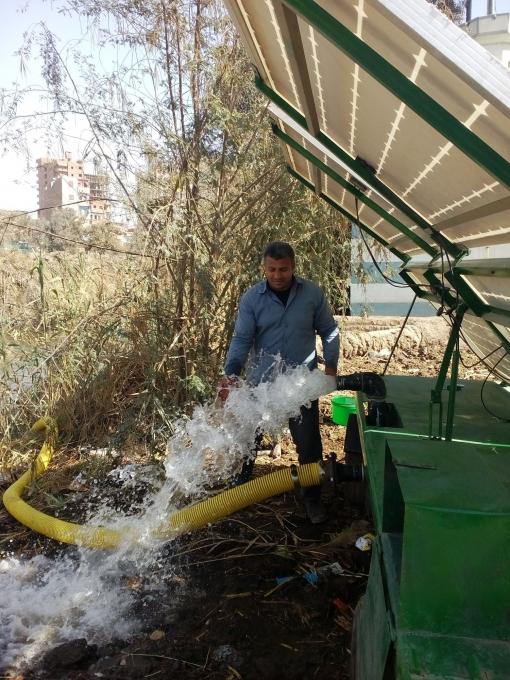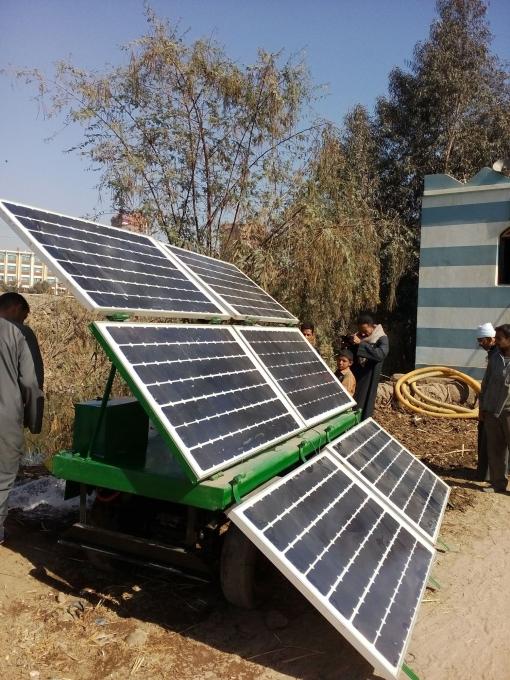Introduction
SunCity is an inclusive business venture from Egypt dedicated to the development of solar farming solutions that can reduce the dependence on conventional fossil fuels. The company participated in the Strategic Advisory Service (SAS) Programme by Global CAD and iBAN and received recommendations on how they could improve their business model. In the end, they experienced that the political and economic situation of the country where you are operating will affect your success, even if you have chosen a customer-centric approach for your business model.
Could you shortly describe what your products are?
We develop diesel pumps that are used for irrigation by small farmers. There are five million small farmers in Egypt who own one acre or less. This number goes up to 500 million all around the world. Those farmers are using diesel pumps for irrigation or they are depending entirely on rainfall. We started to build a mobile solar pump that would give the same performance like a conventional pump.

What does mobile mean? Is it smaller and can it be transported from one field to another?
Mobility means farmers can take it back home once they are finished. If they have fragmented land, they can use the same device repeatedly or they can share it with other farmers who have small properties like theirs. Sharing is something common in farming, in Egypt, and in many countries. We focused on the sharing experience, as that helps farmers to split initial costs, which is the main barrier to adapting solar energy.

Before we started building our product, we talked to customers, small farmers, who are our target audience. What are their daily challenges? What are they looking for in how to change the way they irrigate their fields? What are their expectations for something that could be different from what they are using right now?
Using this information, we built a performance model and used this to build our product. Of course, it took some time and a lot of effort to build something that really works and satisfies the needs of those farmers. We spent two years testing and modifying our product until reaching something that really worked. When we started building the product, there were many issues with it. There was nothing similar in the market worldwide that you could replicate or build on. This is a product that combines a lot of technicalities from different fields from mechanical engineering, to solar engineering, to electrical engineering. The product itself that has a steel structure that has to be built in a specific way. How do you make it as small and efficient as possible? That took time in research and developing and finding the right components to do it.
It was a perfect moment when the farmers saw the mobile solar pump and how it worked perfectly. It even exceeded our expectations in terms of performance and capacity of irrigation. Once we reached this stage, more challenges started to arise.

What are your experiences introducing an innovative product, unknown to your customers?
This is something purely new for me, but I have the passion that something has to change. I grew up in Upper Egypt, very close to the farmers. There is this passion and liability that those who have the knowledge and experience have to do something that will change the lives of people. Those are very small farmers, very poor, very low-income, even though they play a very important role in our lives by providing us with very important agricultural products. I thought that I have to step up and build something new. Maybe I do not have the proper experience in building a new product from scratch and introducing it to the market, but this is a journey of learning, and I think that I will be able to do it.
The first two years you developed your product. What happened after that?
After we finished developing the product and had a good performance, we started to do some marketing, like demonstrations and roadshows, to let farmers get to know it. Farmers are very sceptical when it comes to adopting a new product that they have never seen or tried before. Most farmers depend on a referral when it comes to buying or trying something new. We thought we had to go to the market and let farmers see the product working on the ground. This is what happened for several months. At the same time, we gave some farmers that we knew well the chance to try the product for free for a short period. The performance exceeded their expectations; they were very satisfied with the performance and the feasibility of the product.
Shortly after that, the Egyptian government floated the local currency, so the exchange rate between Dollar and the Egyptian Pound (EGP) skyrocketed. This had an impact on the price of our product, which almost doubled in terms of the Egyptian value. This made it very hard for farmers to pay for it upfront. We built our model based on the expected price at the beginning, which was 25,000 EGP ($2,500 USD). Then, when the exchange rate changed, the price was almost 45,000 EGP. It became extremely hard for farmers to afford this amount of money in one shot. They liked the product, but they expressed they could not afford this at one time and asked for a way to facilitate the payment, in terms of instalment over one to three years. But, as a start-up, we do not have the capacity to do these finance mechanisms.
We started to look for proper funding channels in Egypt. It turned out that almost no financial institution likes to work with farmers. Why? Because most farmers do not meet the requirements of their models. You have to meet certain requirements of collateral in order to be eligible for their financing. We started to talk with the people working in this area about the gap in financing available for green products and for farmers who have difficulties affording new products. There has to be a new channel for financing those farmers, based on the circumstances that they lack the proper collateral. We have been engaged in different discussions and meetings with international financing organizations and those interested in this area in Egypt. This discussion has been around for more than one year, and people are interested. It is about introducing something new to the market, but we are still waiting for something to fix this issue.
What does customer value mean to you?
We think that any innovation has to start with the needs of the customers. Whatever you do, it has to start with them. We did not start building something from scratch in the lab and then introduce it in the market. We started all the way from the customers themselves. We think it is extremely important to understand the needs, challenges and expectations of your customer from the very beginning, before starting to build something. This is especially important for small farmers who might be illiterate, and you have certain expectations about them.
Once you start talking to them, you understand that they are very smart. They understand things perfectly, but in a way that is different from the way that we do it. You understand that their expectations are based on the challenges they face in their work and their daily life. Once you understand this, you will be able to speak the same language and tailor the vision you are working on, based on their mentality. This is extremely important. You have to speak the same language. You have to understand the daily challenges. You have to be aware of the way they understand things, because it might be quite different from those who work on innovation or who work in offices.
What kinds of methods or activities did you choose to find out about the small farmers´ wants?
We did surveys, in the form of friendly discussions, in order to collect data. They had about twenty questions that asked about the usage of the product, the difficulties, the price of the operations, the mechanics of the product they are currently using, the amount of water they expect to use, and the size of the land they irrigate daily.
What were your insights? Was it as you expected it to be?
What really surprised me was how smart the farmers are in what they are doing. They know how to calculate the operation costs really, really well. They do it perfectly. One of the challenges was that they do not have information about the capacity and the performance of the diesel pumps they are using. The way they calculate their capacity is the size of the land they can irrigate per day using the diesel pumps, but they do not have numbers for the amount of water it can pump per hour, for example. Because this is the technical data that we use for building our product, we had to build an assumption about the expected performance of these pumps.
Farmers understand the economics of things really well, but what matters more for them is the price they pay at a certain moment. They may understand that diesel pumps are not good economically, but what is important for them is that at the time of irrigation they do not have to pay a lot of money. They only have to pay for the price of the diesel they use. This is extremely important. If you want to build something that really works for those farmers, you have to build something that would cost them the same amount of money at that time. If you are going to tell the farmer that he has to pay 45,000 EGP, he will tell you that he likes the product, knows the economics and the payback, but it is not going to work. If you make a model, per month or per season, with a certain amount that is equivalent, or maybe more than, what he pays for diesel, then it is going to work. Otherwise, it is going to be very hard.
Regarding the inflation in Egypt, weren’t the prices for diesel going up as well?
It is catastrophic right now. The prices of diesel and other fuels increase dramatically every year. The price right now is extremely high. Farmers suffer a lot of that. The price of diesel affects the price of transportation, the prices of oil and lubricants, and the price of maintenance... But still, the main issue is that the farmers cannot afford the price of a mobile solar pump at one shot.
We might not have found the perfect time to introduce the product, but we are sure that in one or two years from now, things will change dramatically. People will desperately look for something different, and we will find solutions.
Have you thought of modifying your product at some time to make it more affordable?
We thought about this from the beginning and built a product that has only the basic requirements. We did not include any batteries, fancy components, or high-tech things that might be difficult to use or add an additional cost. We looked for the most affordable and technically reliable components we could find in the world. We got components from Italy, France, and China. There is no opportunity to downgrade the product in order to reduce the costs.
The only option is to think of a financing model, a different way to encourage people to use it as a source of income, for example. It takes time and effort. When you bring it to the market, you have to give it a push at the beginning, a sort of facilitation for payment. That would give the customers the trust to try it. As a small start-up, we do not have the financial capacities to do this now.